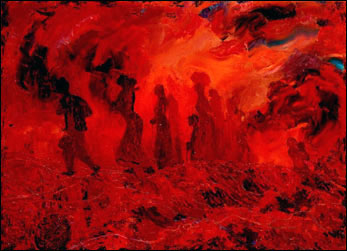 |
| "Refugees" by Afghan artist Akbar Khurasani |
Inspired by the blog A Year of Reading the World: 196 countries, countless stories, I have set out to read the world as well. The more I explore the concept on the web, the more people I find who also set out on this quest. For me, on its surface, it is about exposure and challenging my purview.
While I have read adult novels and YA novels by international authors, I can't recall reading them through the lens of wanting to expose myself to more of the world: Midnight's Children, by Salman Rushdie; Shooting Kabul, by N.H. Senzai; Persepolis, by Marjane Satrapi, et al. As strange as it feels to write, I have always read (I believe) just for the sake of a good story. I'm not embarrassed by that point. But I also realize that writing and reading is too powerful a stone to not turn it over in my hands and gaze into it in new ways. I feel the same way about film.
For my first novel, I started alphabetically by country (Afghanistan) and read The Patience Stone by Atiq Rahimi.
The setting struck me. The entire story occurs in one room. In the center of the room, a war hero lies on mattress. He is motionless, breathing, perhaps conscious. A bullet is lodged in his neck. His portrait hangs on one wall alongside a khanjar or dagger.
The curtains, tattered with holes, hang miserably over the only window. No electricity exists. Gunshots, the groan of tanks, boots on gravel interrupt the story just as quickly as they fade into the distance.
Fog, smoke, darkness. Rain. Patches of blue sky. Thin veils of sunlight. The crunch of broken glass underfoot. Stale bread and a slice of onion. Soot. Spiders. A dead fly.
The setting of The Patience Stone was present in its grittiness.
I am reminded of set design for theater. No amount of light, electricity, paint, wood, or dry ice can create a world on stage without an artist's eye behind it. By that I mean some directors and stage designers fail as much as some succeed. Some take risks. Some cram imaginative ideas onto a set even when it really does not work. A great set design and execution is a part of the story telling experience.
With that in mind, the setting in The Patience Stone resonated with me. As I read, I felt present in a darkened theater. Rahimi led my eyes around the stage. He brought in my sense of hearing. He let me linger. He let me stare at the stillness on his stage.
I am comparing it to when I saw W;t in the late 90s and how I was struck by the rawness of emotion--and nothing distracted me from that grounding, central experience. The rawness of emotion in The Patience Stone came alive because of the setting. This was not a story taking place in no time and no place--but a story taking place in a very specific time and very specific place. And it mattered.
And all it took was one room.
And all it took was one room.
The scorched Earth (and lives) in The Patience Stone are what I will take with me moving forward as I continue to read the world. I will file this away for when I return to Afghanistan for another novel.

No comments:
Post a Comment